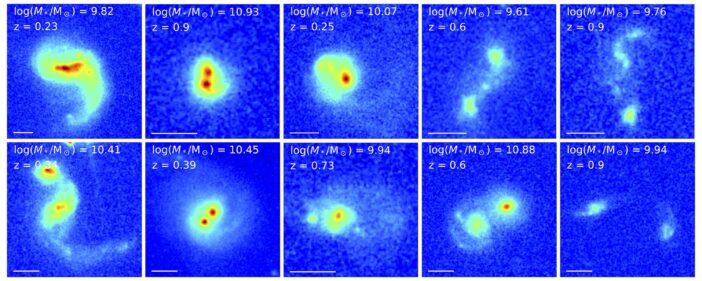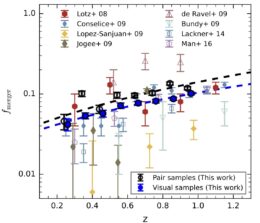Editor’s Note: Astrobites is a graduate-student-run organization that digests astrophysical literature for undergraduate students. As part of the partnership between the AAS and astrobites, we occasionally repost astrobites content here at AAS Nova. We hope you enjoy this post from astrobites; the original can be viewed at astrobites.org.
Title: Revisiting Galaxy Evolution in Morphology in the COSMOS field (COSMOS-ReGEM): I. Merging Galaxies
Authors: Jian Ren et al.
First Author’s Institution: Chinese Academy of Sciences
Status: Published in ApJ
Galaxies are a bit like LEGO. At least, if you simplify down one of the fundamental theories of Lambda-CDM cosmology, our current best model of the universe, what you could say is that all structures in the universe today formed from the merging of smaller structures, much like building up a LEGO masterpiece. So, to build a massive galaxy like our own Milky Way, you need to merge lots of smaller galaxies together first (e.g., see this bite). One day, our galaxy will collide with our nearest neighbour, the Andromeda Galaxy, to form an even more massive galaxy. If you wind back the clock of our universe, what this simple, fundamental idea predicts is that galaxy collisions were more frequent back in the early universe. However, this has been a difficult prediction to prove as it requires observations much deeper into the universe.
Whilst it might seem easy to identify these colossal collisions with nearby galaxies, this gets very difficult for more distant galaxies, i.e., galaxies in the early universe (since distant = higher redshift = longer lookback time). At these distances, we need better instruments and bigger telescopes to resolve enough detail and collect enough light to really identify these more distant and therefore fainter mergers. The authors of today’s article have used observations of the Cosmic Evolution Survey (COSMOS) field — an area of the sky that has been extensively observed by multiple cutting-edge telescopes — to identify merging galaxies and investigate their properties.
How to Spot a Merger
There are a variety of different methods to identify merging galaxies. If you have sufficient spatial resolution, meaning you can see the extent of a galaxy rather than just a point source, you often see the evidence just by eye. In the featured image above, you can see a beautiful example of a local merger. These are called the Mice Galaxies, or NGC 4676. This merger is close enough for us to see it in action — the two galactic nuclei are clearly distinguishable, and we can even see a bridge connecting the two, as well as bright tidal tails of stars and gas streaming away from the collision. The authors of today’s article identified similar features in the COSMOS field. Some examples of these features are shown in Figure 1. In total, they identified 3,594 galaxies out of 33,605 galaxies as mergers by visually inspecting the images and searching for these clues.

Figure 1: Examples of some merging galaxies visually identified in this article. Each square is a different pair of merging galaxies. Each pair is at a different redshift, z, and stellar mass. [Ren et al. 2023]
Sometimes, however, even this method is too difficult. Redshifts can be hard to obtain (e.g., see this bite) and sometimes distances are just too great to even resolve galaxy pairs. For this reason, today’s authors used their impressively huge sample of mergers, pairs, and non-interacting galaxies to investigate some alternative methods that could be useful for a higher-redshift sample. They find that two parameters in particular, M20 and A0, are especially good at identifying mergers. M20 is a measure of how the brightness is spread across a galaxy, and A0 measures the asymmetry of the outskirts of a galaxy. The images of merging galaxies typically have much higher M20 and A0 values than the images of non-merging galaxies. This makes some sense — merging galaxies should show much less structure and symmetry since these collisions are violent and chaotic.
Mergers Across Cosmic Time

Figure 2: How the merger fraction, which is calculated according to the visually identified mergers (blue points) and the number of pairs (black points), varies as a function of redshift, z. Estimates from other works are also shown. Click to enlarge. [Adapted from Ren et al. 2023]
Future efforts by the next generation of cutting-edge telescopes, as already begun by JWST, will help to extend this investigation to higher and higher redshifts. Seeing back earlier in time will paint a picture of galaxy mergers at the beginning of the universe, where the cosmic game of LEGO was likely even more intense and chaotic.
Original astrobite edited by Storm Colloms.
About the author, Lucie Rowland:
I’m a first-year PhD student at Leiden Observatory in the Netherlands, studying massive, star forming galaxies in the early universe with ALMA and JWST. It’s a really exciting time to be interested in astronomy, so I hope to make groundbreaking new research more accessible!

